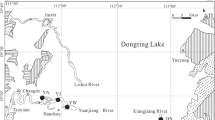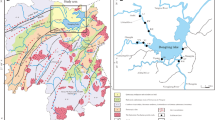Abstract
Sequential core sediments from northwestern Taihu Lake in China were analyzed for grain size, organic carbon and heavy metal content. The sediments are composed of organic-poor clayey-fine silts. The chemical speciations of Cu, Fe, Mn, Ni, Pb, and Zn were also analyzed using the BCR sequential extraction procedure. Cu, Fe, Ni, and Zn are mainly associated with the residue fraction; Mn is concentrated mainly in exchangeable/carbonate fraction and residue fraction; and Pb mainly in Fe/Mn oxide fraction and organic/sulfide fraction. The exchangeable/carbonate fractions of Cu, Fe, Ni, Zn and Pb are lower. The fractions of Ni, Pb and Zn bound to the Fe/Mn oxide have significant correlations with reducible Mn; the organic/sulfide fractions of Cu, Mn, Ni, Pb, and Zn have significant correlations with TOC. The extractable fractions of Cu, Mn, Ni, Pb, and Zn are high at the top 4 cm of the core sediments as compared to those in the deeper layers, showing the anthropogenic input of heavy metals is due to rapid industrial development. The heavy metal pollution history of the sediments has been recorded since the late 1970s, determined by the result of137Cs dating.
Similar content being viewed by others
References
Abraham J. (1998) Spatial distribution of major and trace elements in shallow reservoir sediments: An example from Lake Waco, Texas [J].Environmental Geology. 36, 349–363.
Covelli S. and Fontolan G. (1997) Application of a normalization procedure in determining regional geochemical baselines [J].Environmental Geology. 30, 34–45.
Dai Xiuli and Sun Cheng (2001) The characteristics of heavy metals distribution and pollution in sediment from Lake Taihu [J].Shanghai Environmental Sciences. 20, 71–74 (in Chinese with English abstract).
Föstner U. and Wittmann G. T. W. (1988)Metal Pollution in the Aquatic Environment (Chinese translation edition translated by Wang Zhongyu and Yao Zhonghua) [M]. pp. 31–204. China Ocean Press, Beijing.
Huang Yiping, Fan Chengxin, Pu Peimin, Jiang Jiahu, and Dai Quanyu (2001)The Water Environment and Pollution Control of Taihu Lake [M]. pp. 129–137. Science Press, Beijing (in Chinese).
József Hlava and Klára Polyák (2002) Investigation on the pollution sources of bottom sediments in the Lake Balaton [J].Microchemical Journal. 73, 65–78.
Li Xiangdong, Shen Zhenguo, Wai Onyx W. H., and Li Yok-Sheng (2001) Chemical forms of Pb, Zn and Cu in the sediment profiles of the Pearl River Estuary [J].Marine Pollution Bulletin. 42, 215–223.
Li Xiangdong, Wai Onyx W. H., Li Y. S., Coles Barry J., Ramsey Michael H., and Thornton Iain (2000) Heavy metal distribution in sediment profiles of the Pearl River estuary, South China [J].Applied Geochemistry. 15, 567–581.
Lin Yuhuan, Guo Mingxin, and Zhuang Yan (1997) Determination of acid volatile sulfide and simultaneously extracted metals in sediment [J].Acta Scientiae Circumstantiae. 17, 353–358 (in Chinese with English abstract).
Liu Yingjun, Cao Liming, Li Zhaolin, Wang Henian, Chu Tongqing, and Zhang Jingrong (1984)Element Geochemistry [M]. pp. 80–85. Science Press, Beijing (in Chinese).
Luoma S. N. (1983) Bioavailability of trace metals to aquatic organisms—A review [J].Science of the Total Environment. 28, 1–22.
Lü Yao (1998) The agricultural non-point pollution in Taihu basin and sustainable development [J].Environmental Science Trends. (2), 1–4 (in Chinese with English abstract).
Mustafa Tuzen (2003) Determination of trace metals in the River Yesihrmak sediments in Tokat, Turkey using sequential extraction procedure [J].Microchemical Journal. 74, 105–110.
Oakley S. M., Nelson P. O., and Williamson K. L. (1981) Model of trace-metal portioning in marine sediments [J].Environmental Science and Technology. 15, 474–480.
Qu Wenchuan, Mike Dickman, and Wang Sumin (2001) Multivariate analysis of heavy metal and nutrient concentrations in sediments of Taihu Lake, China [J].Hydrobiologia. 450, 83–89.
Quevauviller Ph., Rauret G., López-Sánchez J. F., Rubio R., Ure A., and Muntau H. (1997) Certification of trace metal extractable contents in a sediment reference material (CRM 601) following a three-step sequential extraction procedure [J].Science of the Total Environment. 205, 223–234.
Şerife Tokalioĝlu, Şenol Kartal, and Latif Elçi (2000) Determination of heavy metals and their speciation in lake sediments by flame atomic absorption spectrometry after a four-stage sequential extraction procedure [J].Analytica Chimica Acta. 413, 33–40.
Sun Shuncai and Huang Yiping (1993)Taihu Lake [M]. pp. 120–224. China Ocean Press, Beijing (in Chinese).
Wang Hai, Wang Chunxia, and Wang Zijian (2002) Speciations of heavy metals in surface sediment of Taihu Lake [J].Environmental Chemistry. 21, 430–435 (in Chinese with English abstract).
Weng Huanxin, Shen Zhongyue, Chen Jianyu, Zhang Xingmao, and Zhong Guolin (2002) Approach to effective species of heavy metals in coastal surfacial sediments [J].Chinese Journal of Geology,37, 243–252 (in Chinese with English abstract).
Yuan Xuyin, Chen Jun, Ji Junfeng, Tao Yuxiang, and Qu Wenchuan (2002a) Compositions and the formative conditions of sediments in Taihu Lake, Eastern China [J].Journal of Nanjing University (Nature Sciences).38, 756–765 (in Chinese with English abstract).
Yuan Xuyin, Chen Jun, Ji Junfeng, Tao Yuxiang, and Wang Runhua (2002b) Characteristics and environmental changes of pollution elements in Taihu sediments and soils near the lake [J].Acta Sedimentologica Sinica. 20, 427–434 (in Chinese with English abstract).
Zhang Jianguang and Zou Guowei (1999) The economy development around Taihu Lake during Tang Dynasty [J].Journal of Suzhou University (Social Science Edition). (3), 98–105 (in Chinese with English abstract).
Zhang Jing (1996)The Biogeochemistry of River Estuary in China [M]. pp. 156. China Ocean Press, Beijing (in Chinese).
Author information
Authors and Affiliations
Additional information
The research project was supported jointly by the Knowledge Innovation Engineering Projects of the Chinese Academy of Sciences and Nanjing Institute of Geography & Limnology (KZCX1-SW-12-I, CXNIGLAS-A02-05).
Rights and permissions
About this article
Cite this article
Liu, E., Shen, J. & Liu, X. Geochemical features of heavy metals in core sediments of northwestern Taihu Lake, China. Chin. J. Geochem. 24, 73–81 (2005). https://doi.org/10.1007/BF02869691
Issue Date:
DOI: https://doi.org/10.1007/BF02869691




